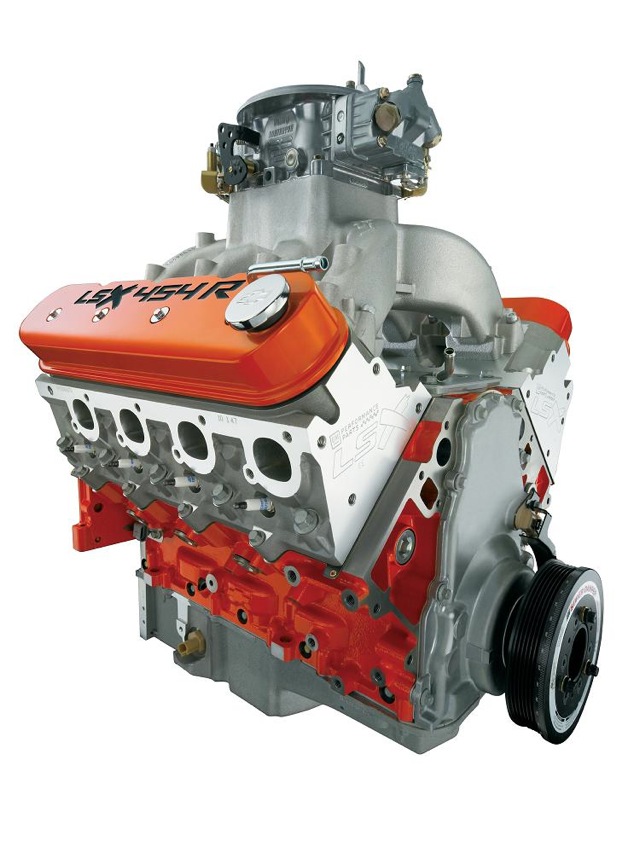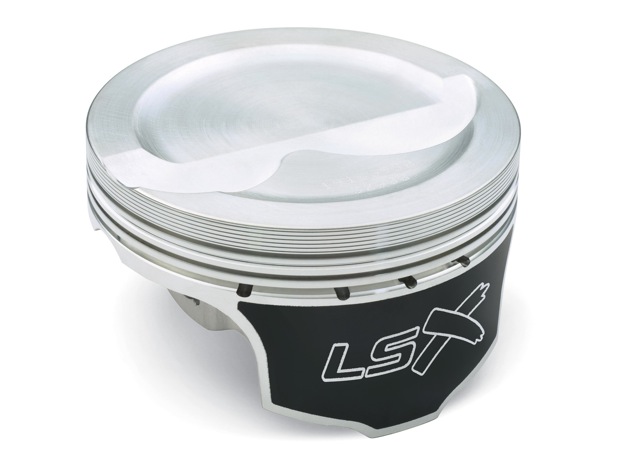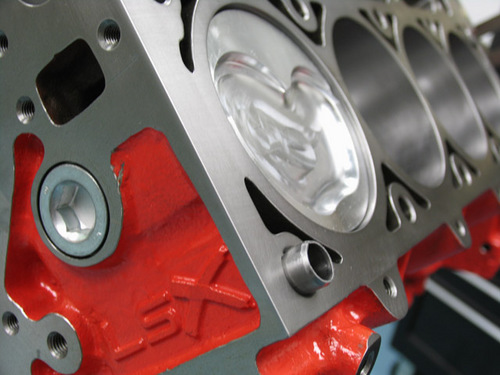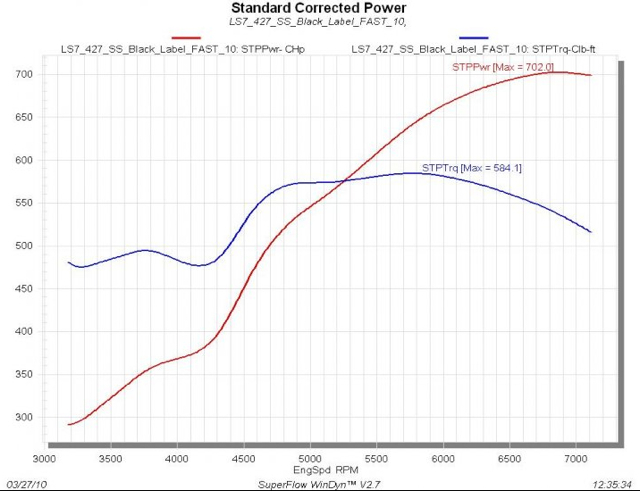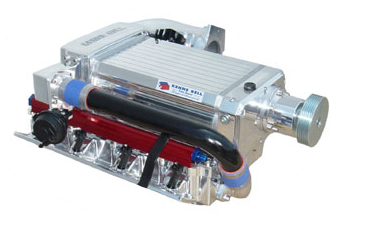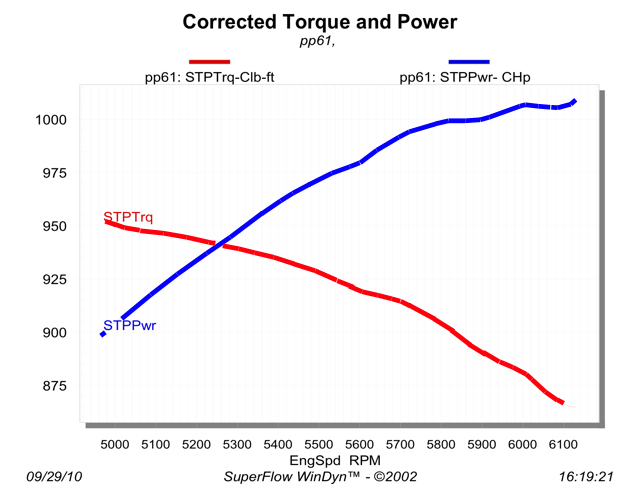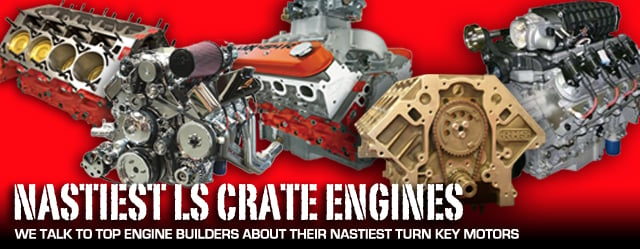 In past decades when you talked about GM high performance engines and GM-based crate engines, the term ‘nasty’ did not apply to both of these categories equally. A nasty GM high performance engine was just that, an offensive, vicious, dangerous and spiteful powerplant that sprayed horsepower all over the asphalt. Crate engines, on the other hand, were offensively nasty in a completely different way. Mild mannered, tame gas guzzlers that talked a big game but never seemed to back it up. When GM introduced the LS engine platform, the entire landscape of crate engines evolved with it.
In past decades when you talked about GM high performance engines and GM-based crate engines, the term ‘nasty’ did not apply to both of these categories equally. A nasty GM high performance engine was just that, an offensive, vicious, dangerous and spiteful powerplant that sprayed horsepower all over the asphalt. Crate engines, on the other hand, were offensively nasty in a completely different way. Mild mannered, tame gas guzzlers that talked a big game but never seemed to back it up. When GM introduced the LS engine platform, the entire landscape of crate engines evolved with it.
Suddenly there was a factory engine that was affordable, lightweight, and produced about one horsepower per cubic inch. Performance engine building shops took notice and rapidly started putting together their own lines of crate engines by mixing factory parts from different LS engine lines and aftermarket parts to produce some of the best fire breathing crate engines that have ever existed. We’re going to take a closer look at four popular manufacturers of LS crate engines and check out a range of “nasty” offerings that are ready to transform your ride, whether you’re looking for pump gas performance on the street, a high-winding naturally aspirated drag race engine, or astounding four-digit power potential.
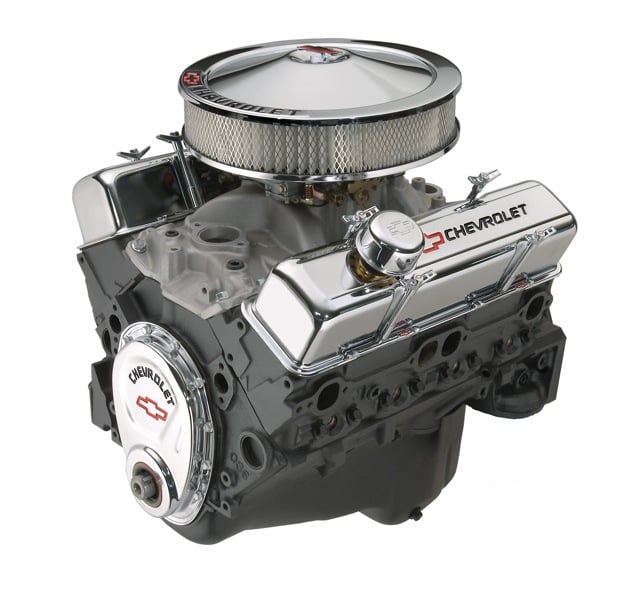
The General Motors Gen I small block V8 engine was truly the genesis of crate engines. In production from 1955 and still available from GMPP in several different variants, we can expect to see the LSx engine platform have a similar lifespan with auto enthusiasts.
The Genesis
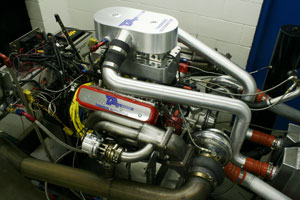
Brian Thomson created the "Frankenstein" LS in which he took an LSX engine with 400 cubic inches, a set of prototype cylinder heads from GM Performance Parts, two 88mm turbochargers, a custom intake, custom ignition system and DFI engine management working together to produce more than 2,000 horsepower.
Replacing the venerable Gen I GM small block V8 engine was not going to be an easy task. Introduced in 1955, the “mighty mouse” was installed in just about every type of vehicle, from cars and trucks to boats and airplanes over the next 48 years. For the LS platform, GM engineers started with a clean sheet design and incorporated several techniques learned from their years of involvement in motorsports and combined them with the best features of the highly successful Gen I V8 engine.
To get some background, we talked with Brian Thomson of Thomson Automotive Engines in Wixom, Michigan. Thomson has spent the best part of thirty five years doing testing for Detroit’s big three and has become widely respected for his work with the GM LS engine platforms. According to Thomson, “GM’s really got a good thing going here (with factory LS engines). These engines are light and make good power. They really put out a good product and they want it to last a long time for people. GM’s LS crate engines hold up really well.”
These engines are light and make good power. They really put out a good product and they want it to last a long time for people. – Brian Thomson
Thomson did acknowledge that you could squeeze more power from these crate engines with some calibration in the tuning and camshaft changes, but those changes shorten the life of an engine. “There’s always that tradeoff and GM can’t try to squeeze every ounce of power out of the engine. They put a warranty on their motors and want them to last for their customers,” said Thomson. GM’s latest crate engine breaks with the traditional however, and with the LSX 454R the Performance Division has squeezed the maximum out of the motor and limited the warranty for the crate engine fans that wanted an off the shelf race motor with higher horsepower.
It’s generally acknowledged that the LS engine platform has caused the entire industry to rethink crate engines and their place in the market. With the economy taking its toll on every motorhead’s disposable income, these engines brought affordable race ready performance out of the box. These two elements combined to make the perfect storm and the market responded with increased demand. In response to the demand, other high performance engine builders began specializing in the LS platform.
The Players
We chose to look at the current LS crates engines from several of the most recognizable names on the playing field:
- Chevrolet Performance and their latest LS crate creation, the LSX454R
- Livernois Motorsports and their 427ci LSX package
- Mast Motorsports and their Mast LS7 Black Label 427ci crate engine
- Turn Key Engine Supply and their 427ci LS7 street crate engine package
We’ve selected these particular packages to show a cross-section of what’s available for your LS project without having to crack open a single parts catalog or wonder if the killer combo you put together in your head will actually work in the real world. Though they’re all very different, they all show that the LS crate engine concept has come of age, for just about any application you can think of.
Chevrolet Performance LSX 454R – 750 Horsepower, 720 Pound Feet of Torque
Born years ago out of factory support for GM’s Trans Am racing teams, Chevy Performance (formerly known as GM Performance Parts) initially planned on shipping race-spec hardware as “No Code” parts so that no one outside the division could track them. Manager Ernie Callard had different ideas and suggested putting part numbers on the parts and making them available to anyone that wanted them for their own cars.
In addition to selling race inspired parts to the public, Callard recognized that GM made more engines than vehicles that were sold. Callard’s group took the extra engines, put them into crates and sold them as replacements thereby coming up with the concept of “crate engines.” Today, the Chevy Performance division of GM work with race teams and third parties in developing high performance parts for distribution through the GM dealer networks.
LSX454R (Part #19257880):
- Engine Type: LSX Series, Gen IV, small block V8
- Displacement: 454 cubic inches (7.4 L)
- Bore X Stroke: 4.185” X 4.125”
- Block: LSX cast iron with 6 bolt cylinder head attachment cross-bolted main caps.
- Crankshaft: 4340 forged steel 2.560” main journals, 2.100” connecting rod journal, uses 8 bolt flexplate/flywheel attachment, internally balanced.
- Connecting Rods: 4340 forged steel I beam, 6.000” center to center, 2.100” big end, 0.866” wrist pin.
- Pistons: Forged 4032 aluminum with skirt coating 4.180” diameter with 0.866” steel wrist pin.
- Ring pack: Top ring- steel with plasma face 1.2mm, Second ring- cast iron 1.2mm, Oil ring- 11 lb, 2.0 mm
- Bearings: Mains -Clevite MS-2199H, Rods- Clevite CB-663H
- Camshaft type: Hard ground steel mechanical roller camshaft.
- Valve lift: 0.738” intake / 0.738” exhaust
- Camshaft Duration at 0.050”: 250 degrees intake / 270 degrees exhaust
- Lobe separation angle: 108 degrees
- Lifters: Tie bar style mechanical roller lifters
- Harmonic Balancer: ATI–SFI approved
- Reluctor Wheel: 58X
- Intake manifold: Large plenum aluminum with 4500 series carburetor flange, cast in bosses for dual stage nitrous oxide
- Carburetor: 4500 series Holley 1150 CFM
- Fuel: Race fuel (110 octane minimum)
Cylinder heads
- LSX-DR, 11 degree aluminum, six-bolt with fully CNC’d 313 cc intake and 116 cc exhaust runners and 50cc fully CNC’d chambers
- Flow: Intake- 435 CFM at 0.800” lift at 28” water pressure; Exhaust- 252 CFM at 0.800” lift at 28” water pressure
- Valves: Single piece stainless steel
- Valve size: 2.250” X 6.350” Intake, 50 degree seat / 1.625” X 6.350” Exhaust, 50 degree seat.
- Rocker Arms: Shaft mounted 1.9:1 ratio rocker arms with needle bearing fulcrum and tip
- Compression Ratio: 13.1:1
Chevy Performance’s Product Integration Manager, Dr. Jamie Meyer, introduced the king of GM crate motors by saying, “This is a great engine to use when building a cutting-edge drag car with one of our bodies-in-white.”
Others within GM’s performance branch were saying that the bulletproof bottom end featured a forged rotating assembly with a cast iron block that could handle higher cylinder pressures created by power adders like superchargers, turbochargers and nitrous, though the high compression ratio will require a piston swap for pressurized applications.
When this factory crate engine was unveiled, LS fans raised their collective eyebrows when it was announced that the output was rated at a conservative 720 horses at 6,000 RPM. Dyno numbers also showed a peak 720 foot pounds of torque at 4,500 RPM. These numbers made the LSX 454R the most powerful LS engine offered to the public by the factory.
Meyer went on to explain the goal behind this engine. “The engineers designed the LSX 454R for the high-RPM demands of drag racing. The high compression, solid roller combination with LSX DR cylinder heads with raised ports are matched on the engine with an all new high-rise open-plenum intake and Holley 1,150 CFM Dominator carb to provide tremendous airflow.”
Livernois Motorsports 427 – Rated to 2,500 Horsepower
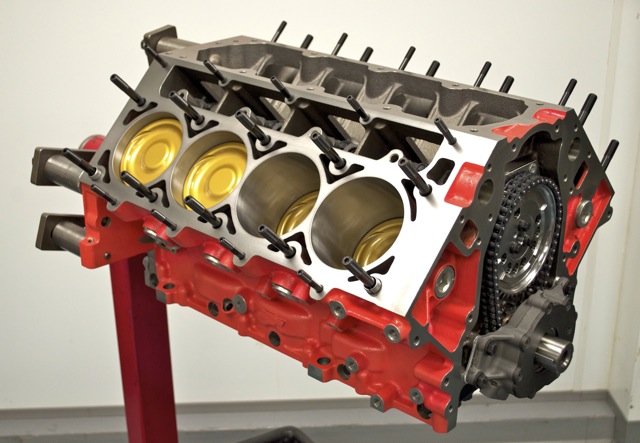 While the LSX454R is a great naturally-aspirated LS powerplant, many people are looking for a little boost, and our next nasty crate is designed to handle just about any turbo(s) or superchargers you can strap on.
While the LSX454R is a great naturally-aspirated LS powerplant, many people are looking for a little boost, and our next nasty crate is designed to handle just about any turbo(s) or superchargers you can strap on.
Livernois Motorsports is no stranger to assembling engines with bad intentions and huge horsepower. Becoming increasingly well known for their work with the LS engine platforms, Livernois provides everything from flow testing to engine dyno work for the factory boys.
Livernois 427 cubic inch LSX:
- Engine Type: LSX Series, Gen IV, small block V8, (fully prepped, honed, bored)
- Displacement: 427 cubic inches
- Bore X Stroke: 4.125″ x 4.000″
- Block: LSX Block with ARP main studs
- Crankshaft: Callies Pro-Billet crankshaft
- Connecting Rods: GRP aluminum rod
- Pistons: Custom built forged Diamond pistons (Livernois proprietary, not available off the shelf ) .220 wall H-13 wristpins, heat coating & skirt coating
- Rings: Total Seal stainless rings
- Bearings: Clevite Tri-Armor coated rod & main bearings
- Camshaft type: LSM custom camshaft
- Lifters: COMP Cams roller lifters
- Harmonic balancer: ATI balancer
- Reluctor wheel: 58X
- Max RPM: 8500 rpm
- Intake manifold: GM LSX Drag Race
- Fuel: C16 Race Fuel
Cylinder heads
- GM LSx Drag Race CNC Ported Heads, 11 degree aluminum, six-bolt with fully CNC’d 313 cc intake and 116 cc exhaust runners and 50cc fully CNC’d chambers
- Flow: Intake 430 CFM @ .800 / Exhaust 260 CFM @ .800
- Valves: Ferrea
- Valve size: 2.250” intake / 1.625” exhaust
- Rocker Arms: T&D shaft rocker system with Trend pushrods
- Compression Ratio: 9.1:1
- Cometic Head Gaskets
Livernois engine department supervisor Mike Schropp was pretty excited to tell us about their latest LSX crate engine monster. “The LS series is a great engine platform,” says Schropp. “GM has given us a great starting point and we’ve put a lot of research and development time into fine tuning what gives our customers a good return on their investment,” he added.
While the concept of crate engines generally is thought of as an off the shelf part, Livernois Motorsports rarely keeps many of these type of engines laying around waiting for a customer to call. These engines are built on demand and Schropp assures us that the customer can request optional parts depending on the application. For all intents and purposes, these are custom-built crate engines without the expense of a fully customized engine build.
Because the ultimate horsepower and torque numbers for this crate engine really depend on how much air the blower or turbocharger can provide, it’s hard to pin down exact numbers – Livernois simply is confident to say that this combination will survive and thrive all the way up to 2,500 ponies at the crank!
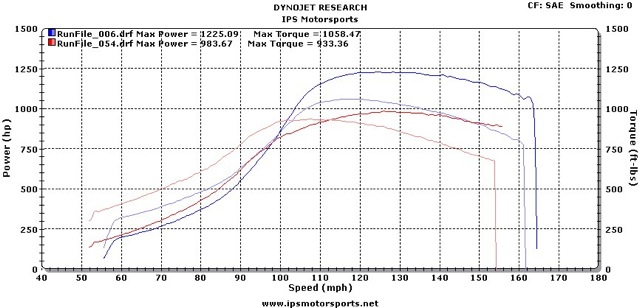
Livernois 427ci LSX dyno run sheet showing 'only' 1,225 horsepower - on a boosted engine like this, the limiting factors are how much air you can force into it, and how much punishment the long block can survive!
Mast Motorsports LS7 Black Label 427 Turn Key – 700+ Rear Wheel Horsepower
Let’s say you’re not shooting for high sixes in the quarter mile – instead, you’d like a LS crate engine that will run on pump gas, but still smoke the tires at freeway speeds. Mast Motorsports will be happy to help fill that gap between your fenders.
Mast Motorsports LS7 Black Label 427
- Engine Type: LS7, Gen IV, small block V8
- Displacement: 427ci
- Bore X Stroke: 4.125 x 4.000
- Block: GM LS7 Aluminum with ARP main studs
- Crankshaft: Callies Forged 4.000″ stroked crankshaft
- Connecting Rods: Callies forged H-Beam
- Pistons: Mahle Motorsports forged pistons
- Ring pack: Mahle
- Bearings: ACL Rod and Crank Bearings
- Camshaft type: Mast 3-Bolt custom hydraulic roller cam
- Valve lift (with 1.7 ratio rockers): .639 intake .639 exhaust
- Camshaft Duration at 0.050”: 236 degrees intake / 250 degrees exhaust
- Lobe separation angle: 114
- Lifters: GMPP Cadillac Hydraulic Roller Lifters with Mast Black Label pushrods
- Harmonic Balancer: F-body, Y-body or truck water pump, balancer and oil pan.
- Reluctor Wheel: 58X
- Max RPM: rev limited to 7,250 rpm
- Intake manifold: FAST LS7 Intake
- Fuel: Pump gas (91 octane minimum)
Cylinder Heads
- Mast 12 degree CNC LS7 Heads, 6 bolt 4.125″ bore, 274cc intake port,
- Flow: Intake- 395 CFM at 0.700” lift at 28” water pressure; Exhaust- 249 CFM at 0.700” lift at 28”
- Valves: Mast hollow stem intake, Mast Inconel exhaust with Mast premium nitrided dual springs
- Valve size: 2.200″ intake 1.600″ exhaust
- Rocker Arms: Shaft mounted
- Compression Ratio: 11.4:1
- Cometic head gaskets
Founded in 2006 by Horace Mast, Mast Motorsports has focused on carving a reputation as the “go-to” guys with fuel injected crate engines. “What makes us different,” says Mast, “Is that our crate engines feature our electronic control units, our fuel injection systems, our camshafts, and our know-how of how the parts fit together to create a whole new engine package.”
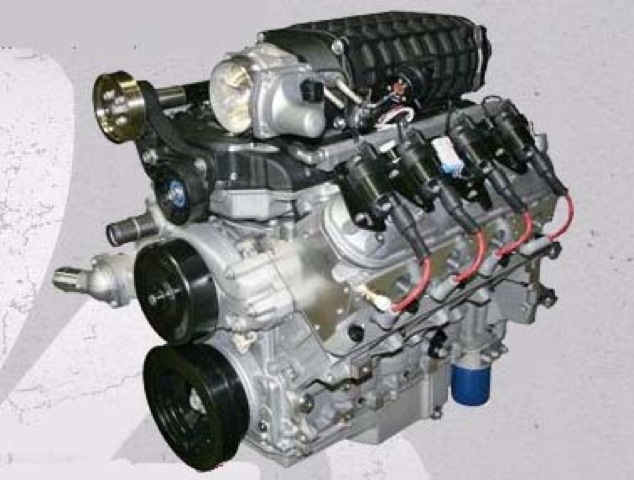
Though we're highlighting a naturally-aspirated combo in this article, Mast Motorsports is no stranger to forced induction, either...
Mast tells us that their most popular crate engine is the LS7 Black Label 427 cubic inch turn key naturally aspirated engine that runs off pump gas and makes over 700 horsepower to the rear wheels. “It’s got a pretty aggressive cam and sounds pretty mean, but with our controller, it’s tame enough to drive on the street,” explained Mast. At over 700 ponies, your car will undoubtedly be the coolest ride in your kid’s car pool.
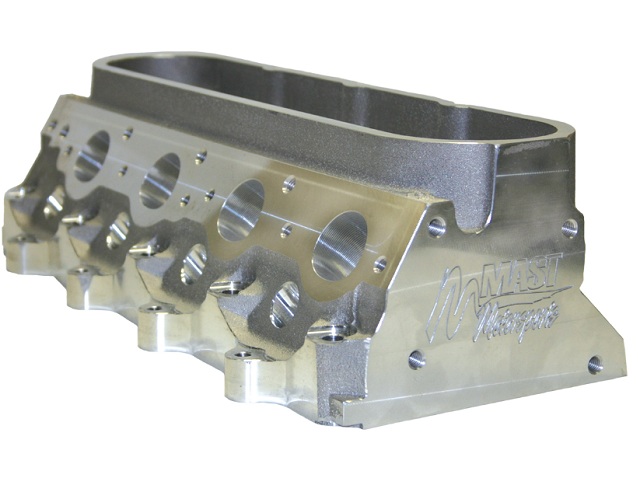
One of Mast Motorsports' claims to fame is their cylinder heads, and they don't hold back the good stuff on their crate engines.
Designed to run on 91-93 octane gas, Mast’s M90 calibrated ECU handles the timing and tuning duties easily, even with the higher 11.4:1 compression ratio on pump gas. The beefed up bottom end can handle a lot of abuse but has been rev limited to 7,250 RPM to keep it from winding too hard.
Turn Key Engine Supply Supercharged Street 427 – 800 Horsepower, 780 Pound Feet of Torque
The concept behind Turn Key Engine Supply is to manufacture and sell complete engine packages with no additional parts needed for your engine. Started in 2002 by Kolby Enger, all the engine work is done in-house and once you’ve installed the engine there are as few as five wires to hook up. Turn Key makes it’s own engine mounts, pulleys and adapter plates, as well as offering engine dyno service, chassis dyno service and full machine shop services. According to Kolby’s brother Kory Enger, “We’re pretty much a one-stop shop.”
Turn Key Engine Supply 427ci LS7 pump gas street crate engine:
- Engine Type: LS7 Gen IV, small block V8
- Displacement: 427ci
- Bore X Stroke: 4.125 x 4.000
- Block: Cast aluminum block with ARP main studs
- Crankshaft: 4340 forged steel crankshaft
- Connecting Rods: Forged H-Beam connecting rods with ARP rod bolts
- Pistons: Mahle forged pistons
- Ring pack: Mahle ring pack
- Bearings: Clevite main and rod bearings
- Camshaft type: COMP Cams custom hydraulic roller camshaft
- Valve lift: Proprietary
- Camshaft Duration at 0.050”: Proprietary
- Lobe separation angle: Proprietary
- Lifters: Delphi Hydraulic Roller
- Harmonic Balancer:
- Reluctor Wheel: 58X
- Max RPM: 6600
- Intake manifold: Cast aluminum intake manifold with 90mm mechanical throttle body, supercharged
- Fuel: Pump gas (91-93 octane)
Cylinder heads
- Dart CNC ported heads, 279cc intake, 70cc combustion chamber
- Flow: 358 CFM at 0.650” lift at 28” water pressure
- Valves: stainless steel intake and exhaust
- Valve size: 2.16″ intake / 1.59″ exhaust
- Rocker Arms: 1.7 ratio
- Compression Ratio: 9.0:1
Located in Oceanside California, the Engers and a staff of full-time employees have been turning out complete engine packages for vehicles all over the world; in addition to the domestic market, they also have customers in South Africa, Germany, Dubai and Australia.
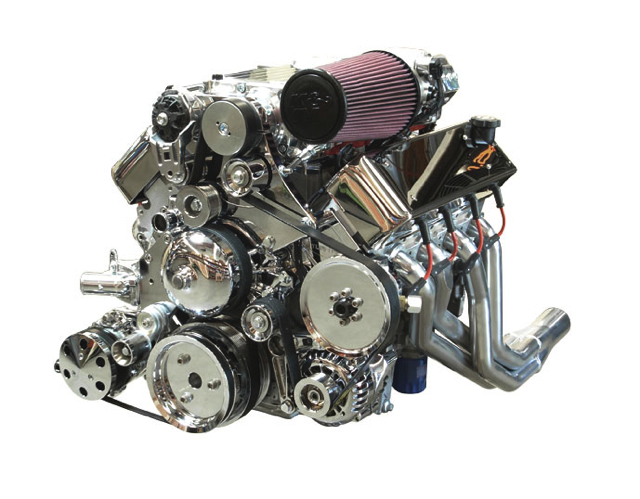 Kory Enger, who does all of the ECU calibrations for Turn Key, told us about their nastiest LS crate engine. “Our pump gas street 427 crate engine is about as exciting as it gets. It’s a real tire smoker. This engine has great low end torque and the Kenne Bell supercharger adds lots of power throughout the power curve. On pump gas, this package will run 800 horsepower and 780 peak torque on the dyno.”
Kory Enger, who does all of the ECU calibrations for Turn Key, told us about their nastiest LS crate engine. “Our pump gas street 427 crate engine is about as exciting as it gets. It’s a real tire smoker. This engine has great low end torque and the Kenne Bell supercharger adds lots of power throughout the power curve. On pump gas, this package will run 800 horsepower and 780 peak torque on the dyno.”
For the guys that want big horsepower without having to worry about trying to put a lot of expensive components together and hoping that they work, Turn Key’s street ready 427 complete crate might be the way to go.
The Future and Beyond
The LS engine platform is a perfect base for mixing and matching factory and aftermarket parts to achieve different power levels. Chevy Performance’s Bill Martens explained that the LS engine platform, “was intentionally designed and engineered for part interchangeability.” In making the LS blocks and heads agreeable and responsive to parts swaps, we can reasonably expect engine builders to continue to stretch the boundaries looking for more reliable power from their own off the shelf custom crate engine designs.
Given the history of the Gen I small block Chevy engine, coupled with GM’s direction to make the LS family the only V-8 engine used in General Motors’ line of rear-wheel-drive cars and trucks, we can also expect a very long run on this engine platform with some variations and tweaks along the way. We’ve brought you a wide variety of LSX off-the-shelf creations from experienced GM engine builders, and without hesitation, we can promise more of the same from these builders as time and R&D progresses. Its fair to say that we are somewhere near the beginning of this evolution and it will continue to get better from here. Secretly, we are wondering how high can the horsepower numbers go in in these custom crates, and when can we get there?




